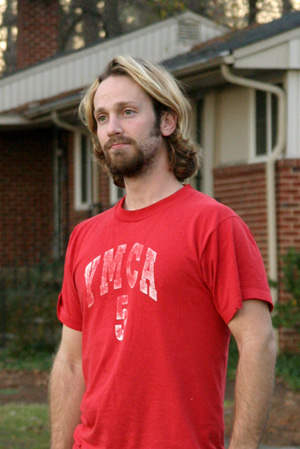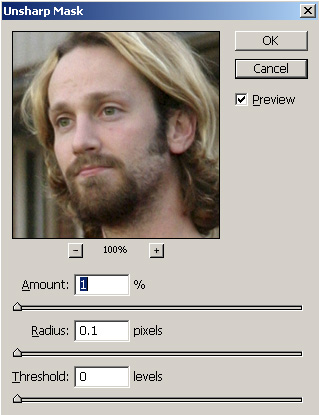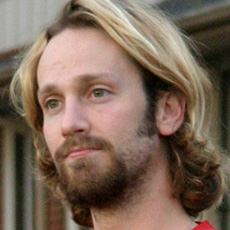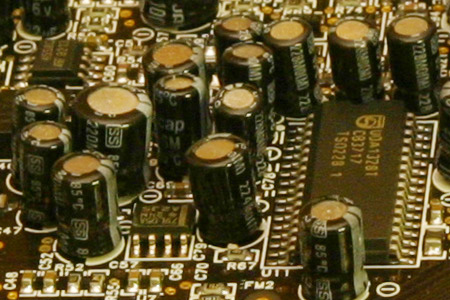Sharpening
If you didn't know already, one of the best sharpening tools available in Photoshop and Elements is called Unsharp Mask (under the Filter\Sharpen menu). It should always be one of the very last things that you do to an image after editing and resizing. Because sharpening is such an important part of making a good image look great, we are going to give you some basic input boundaries for the Unsharp Mask (USM) dialog. Also, because we often see over-sharpened images on the web, we are going to provide some examples of what over-sharpened images look like.
First off, do all your exposure adjustments, color correction, etc. Resize your image for whatever application for which you intend the image to be used. Our example below is going to be used for the web, so we have resized it to 535x800 pixels (the thumbnail is 300x449 pixels).

Original image
Click to enlarge.
1) Set your image magnification to Actual Pixels. To do this, double-click on the Zoom tool in the tools palette. This is very important so that you can see the effect on your image as you adjust the parameters.
2) Open up the USM dialog by going into the Filter\Sharpen menu.

PUSM dialog
You'll see three adjustment sliders: Amount, Radius, and Threshold. Unfortunately, there's no way for us to tell you what to put in these fields. The best settings will depend on the detail in the photo, original sharpness, and your subjective sharpness tolerance. However, we can tell you what the adjustments will do. Think of the Amount slider as a gain control; it will determine how much sharpening to apply. Since Unsharp Mask is essentially sharpening the edges in your image, the Radius will determine how many pixels from the edge to sharpen. Finally, think of the Threshold as a tolerance slider. If the Threshold is lower, more pixels will be considered part of the edge. If the Threshold is higher, fewer pixels will be considered part of the edge. In other words, a higher Threshold will result in less sharpening. Now, let's look at a real example.
3) In the image below, we indicated a moderate Amount of 150%. By choosing a Radius of 1, we were able to bring some definition into the eyes. For the Threshold, we specified 4 to keep the background grain from being sharpened too much.<

Click to download sharpened image.

(Amount 150%, Radius 1, Threshold 4)
Hold mouse over image.
Now, let's take a look at what would happen if we changed the Radius to 2 instead of 1 while keeping the other settings the same. Roll your mouse over the image below to see the difference.

(Amount 150%, Radius 2, Threshold 4)
Hold mouse over image.
Notice how we start to lose detail in the hair and eyes as the contrast increases dramatically. By setting the Radius too high, we have introduced what are known as halos to our edges. As a general rule, you should use a Radius of 1 or so along with a Threshold of 4 or more when you are looking for a softer effect on images with considerable detail. We should also point out that when printing an image, you can get away with much more sharpening in general than when viewing an image on a monitor. We highly suggest experimenting with different sharpness settings and compare the differences when they are printed on a high quality printer.
When you want to sharpen an image with a lot of fine detail, you will want to lower the Radius and Threshold. We do this all the time when we sharpen our product photos. Hold your mouse over the image below to see the difference.

(Amount 255%, Radius 0.5, Threshold 6)
Hold mouse over image.
By selecting a Radius of 0.5, we were able to sharpen the fine details of this sound card. When using lower Threshold amounts, you have to be very careful about over-sharpening the grain (noise). In the example above, we selected a Threshold of 6, which allowed us to avoid sharpening any unnecessary noise.
To demonstrate why it is important to set a low Radius for images with fine detail, we kept the Amount and Threshold settings the same while boosting the Radius to 2. Hold your mouse over the example below to see what happens.

(Amount 255%, Radius 2, Threshold 6)
Hold mouse over image.
As you can see, with a Radius of 2, we start to lose significant detail to halos at the edges. The only way to become experienced with Unsharp Mask is to experiment with it until you know what works for different types of images. As we said before, images destined for print can be sharpened more than images for the screen or web. Just create some samples and compare the printed results.

















20 Comments
View All Comments
Bobby Peru - Thursday, June 23, 2005 - link
Would love it if you'd describe batch processing of photos. With Photoshop or, I think the simplest way is running ImageMagick on Linux or Windows Cygwin. You can just whack a whole folder of 100 photos with one simple command line. The underlying DSP algorithms are basically identical to Photoshops's.buttwhacker - Wednesday, April 13, 2005 - link
good article, very informative and i hope u can add to this article.THEJUICE - Tuesday, March 29, 2005 - link
Useful article and enjoy the series. Thanks.vladik007 - Thursday, March 24, 2005 - link
wouldnt it be better just using selection , feather , and adjusting color channels insidethat selection ?red is usually 100% , so you take it down to 5- 10 % , green and blue are best at 50 % in red channel...
never really liked burn tool for red eye ...
stephencaston - Monday, March 21, 2005 - link
#15,I assure you the original image was not doctored. That would defeat the purpose of post-processing ;-) We've updated the page to include a link to the original file. To get the brush to the right size, use the "[" and "]" keys to increase and decrease the brush size. In our example, the Color Replacement Tool is actually desaturating whatever you paint. So, if you can't get the brush to the exact size, it is best to select a smaller brush and paint around inside the pupil until the red-eye is gone. Good luck!
E Scott Channell - Monday, March 21, 2005 - link
I'm curious how the red-eye sample photograph was obtained... the red-eye region appeared to match the paint-brush shape perfectly... Sometimes getting good results takes a wee bit of fiddling so if this was a doctored "good photo" used for illustration it would provide unreasonable expectations as to what a "quick fix" can achieve.Also, if this is a doctored photo the article should make mention of that.
jeffbui - Sunday, March 20, 2005 - link
Good article as well. An amateur has to start somewhere.Gatak - Sunday, March 20, 2005 - link
Actually. Have you tried to do basic stuff like levels, curves and channel mixer with Gimp? The results are inferior to that of Photoshop, especially when you use 16bit/channel mode.AnandTech, you should do a article where you compare photoediting steps between Photoshop and Gimp.
PrinceGaz - Sunday, March 20, 2005 - link
Nice article if you use Photoshop [Elements]. Did Adobe sponsor this article, Stephen?Everything you told people how to do with Photoshop can be done just as easily with Paintshop Pro, the full version of which costs only slightly more than Photoshop Elements, but isn't a cut down version like Elements is. Unless it came free with the camera, or a scanner, you'd have to be crazy to go the Photoshop route just for tweaking your pictures when much cheaper and equally good options are available.
Even splashing out for Paintshop Pro is probably unnecessary for the vast majority of people who will find everything they need available in the freeware image program 'The Gimp'. It might have been better to assume people were using The Gimp rather than Photoshop, as everyone can download The Gimp free of charge (legally).
unhaiduc - Sunday, March 20, 2005 - link
great article, i read every one of your photo tutorials and loved every bit of it!cant wait for the next one :)